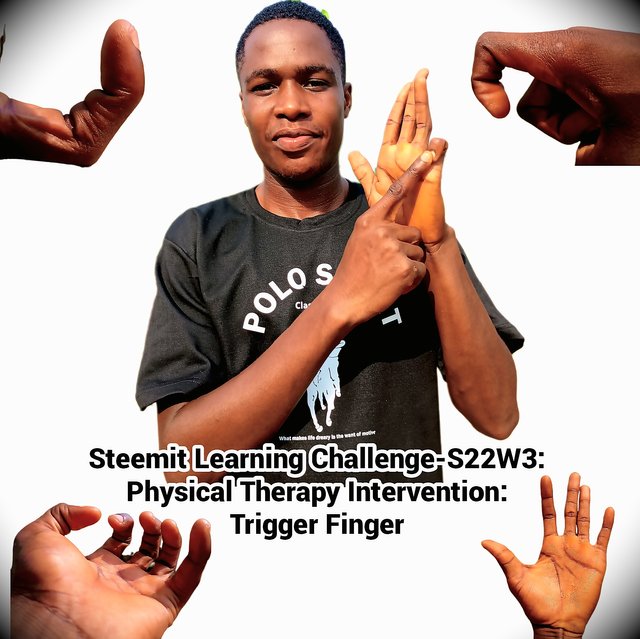Steemit Learning Challenge-S22W3; Trigger Finger"

I'm thrilled to be participating in the "Steemit Learning Challenge-S22W3; Trigger Finger". This challenge offers a fantastic opportunity for us to learn about trigger finger and explore ways to improve our overall well-being through therapy. Let's dive into this educational journey together, focusing on the following themes:
What's trigger finger? Write in your own words after getting knowledge from the lesson post. (Note: don't add special tests or investigations and detailed treatment in this question. Write the answer precisely). |
|---|
Trigger finger, also known as stenosing tenosynovitis, is a condition that affects the movement of our fingers or thumbs. This happens when our fingers become inflamed or irritated. When the tendon sheath becomes inflamed, it can cause the tendon to stiff or lock, making it difficult for the victim to bend or straighten the affected finger.
The locking or stiffened sensation is often accompanied by a clicking or snapping sound, which can be painful and unsettling. In some cases, the finger may become stuck if they victim adjust it to bent position, which will require manual force to straighten it.
Causes of trigger finger?
Repetitive actions
Typing, using a computer mouse, playing musical instruments, or gripping and grasping objects, can cause the tendon to become inflamed. I recall a 12-hour computer mouse marathon that left my fingers stiff and stuck the next day. This personal experience illustrates how repetitive actions like using a computer mouse, typing, or playing musical instruments can indeed lead to trigger finger.
Trauma or injury
Trauma or injury to the finger or hand can also trigger the condition. For instance, if someone sustain a sudden injury or blow to the finger, it can cause the tendon sheath housing the tendon to become inflamed, which at last will lead to trigger finger.
Age
Age can also play a role in the development of trigger finger. From the age of 40 and above, people do experience this kind of condition.
Symptoms of trigger finger?
Pain or tenderness in the affected finger
This pain can happen when bending or straightening the finger, and can start from low pain from severe. If left untreated, the pain can spread to the palm or back of the hand.
Stiffness or limited mobility in the finger
The patient might find it tough to bend or straighten the finger, especially after not using it for a while. This stiffness can be really frustrating and make everyday tasks tricky or hard.
Locking or catching of the finger
Locking or catching of the finger is a symptom of trigger finger that can be quite debilitating. The finger may lock if it adjusted to bent position. When it happens this way, it'll require manual force to straighten it. This manual force trying to straighten the affected finger back may be painful and can make it difficult to perform everyday activities too.
Stages of trigger finger?
Stage 1(Mild): Inflammation and Tendon Irritation.
In this early stage, tendon sheath becomes inflamed and irritated. Also when bending or straightening the finger, pain and stiffness will be felt.
Stage 2(Moderate): Nodule Formation.
This second stage can cause the tendon to catch or lock when moving the finger. Pain and stiffness will be severe compared to stage 1, and clicking or snapping sensation may occur during this stage too.
Stage 3(Severe): Tendon Thickening.
During this stage, the tendon will find it dificult to move because the tendon sheath will be narrowed. The chronic inflammation during this stage will make the tendon becomes thickened and scarred.
Stage 4(Persistent): Chronic Triggering.
In stage 4, the affected finger becomes stiff and difficult to move. The pain and discomfort are no more periodic but constant.
Stage 5(Chronic): Permanent Damage.
In the final stage, the chronic inflammation and scarring cause permanent damage to the tendon and tendon sheath. Unlike the early stages where the stiffness in the finger are periodic, during this stage, finger becomes permanently stiff and deformed. The pain felt during this stage is severe.
How would you diagnose a trigger finger? Any clinical investigation or assessment tests? |
|---|
Patient History/Investigation
Getting the patient's medical history will help to identify any underlying conditions that may be contributing to the symptoms. After getting the history, I'll do some basic investigation by asking the following questions;
How often do you use your fingers for daily tasks and work?
What kind of work do you do, and have you noticed any changes in your finger symptoms since starting this job?
Can you tell me about your workplace and what you do every day?
Understanding a patient's occupation and daily activities is very important in diagnosing trigger finger. People who do the same movements over and over, like: Typing on a computer, building things with their hands (carpenters), laying musical instruments, are more likely to get trigger finger.
Physical Examination
I'll carefully look at the affected finger to check for swelling, redness, or unusual shape. If i notice something like that, I'll ask the patient to try and fold the finger down to the palm to see how flexible it is.
Imaging Test
Ultrasound
Using the ultrasound will make it easy for me to see the movement of the tendon, checking for the inflammation or thickening, and understanding the causes of the symptoms.
X-ray
Using of X-rays in the diagnostic process for trigger finger patients is crucial, as it enables me to rule out other conditions that may have the same symptoms, such as arthritis, or bone spurs.
MRI
An MRI is not usually the first test for trigger finger. It's typically used only when other tests have been done and there's still something unclear or suspicious.
Clinical Assessment
Tenderness check/palpation
To help me diagnose the issue, I'll gently press on the affected finger, specifically on the palm side, to see if it's tender. I'll focus on the area where the tendon moves through its covering, as this is often where inflammation happens in trigger finger cases. During the process, I'll be flowing with the patient asking him/her where the pains is felt, and their feedback will definitely help me during the assessment.
Range of motion
In this clinical assessment, I'll take the patient through 3 types of range of motion movement which includes;
- Flexion: The patient bends their finger toward their palm.
- Extension: The patient straightens their finger.
- Rotation: The patient rotates their finger in a circular motion.
Special test
Finkelstein Test
- Patient Positioning: Patient's hand is in a fist with the thumb inside.
- Examiner Action: Examiner grasps patient's hand and deviates the wrist toward the ulnar side (little finger side).
- Positive Test: Pain or clicking at the base of the thumb or in the wrist indicates a positive test.
Trigger Finger Test
- Patient Positioning: Patient's hand is flat on a surface with fingers extended.
- Examiner Action: Examiner applies gentle pressure to the affected finger, forcing it to flex.
- Positive Test: Clicking or snapping sensation indicates a positive test.
Nodule Test
- Patient Positioning: Patient's hand is flat on a surface with fingers extended.
- Examiner Action: Examiner palpates (feels) the tendon at the base of the affected finger.
- Positive Test: Tenderness or nodules indicate a positive test.
Try to practice at least 3 exercises that you have learned from the lesson. Share images, gifs or videos while practicing preferably gifs or videos. |
|---|
Finger Extensor Strengthening
Massage Of Finger Joints
Trigger Finger Stretch
Share your review after performing these exercises either on yourself, a healthy individual, or a patient. |
|---|
I had the opportunity to try out the exercises on myself, starting with finger extensor strengthening, followed by massage of finger joints, and finishing with the trigger finger stretch. It was engaging to put these exercises into practice for the first time.
For the finger extensor strengthening exercise, I utilized a short rubber band to provide resistance while straightening my fingers.
During the finger joint massage, I noticed a bony prominence at the joint, which initially caused concern. However, I recalled that the lesson mentioned this sensation, and I continued with the exercise.
Interestingly, while performing the trigger finger stretch, my other fingers experienced a shivering sensation, although I'm unsure of the reason behind this. Nevertheless, I persisted and completed the three steps of the exercise.
Dear Teacher @ashkhan, i've completed my homework task after thoroughly reviewing the lesson. I'm eager to continue learning and look forward to joining the next class.

https://x.com/allicrypto01/status/1874916526576607570?t=_4mBxvcGdMft6AtdSbtVBw&s=19
Challenges like this are tough, but they remind us of how powerful the human spirit can be. You're doing amazing.
Hey max. Thank you for stopping by, i really appreciate 😊
Thank you for understanding the lesson and sharing your assignment; I hope that you will enjoy this week's lesson and try to implement it in your life if you see any such case.
Observations
Task 1 (2.8/3)
You have shared great knowledge about the trigger finger, its symptoms, causes, and stages, but it would be better to add the names of the stages that are written in the lesson post. I appreciate your effort.
Task 2 (2.9/3)
In the second question, you tell us about how you have to assess a patient by doing physical examination, history taking, special tests and investigations. But it would be better to add one more investigation that is NCS to assess the nerve involvement. Great.
Task 3 (3.7/4)
You try the finger extensor strengthening, trigger Finger stretch, finger joint massage. You did the trigger finger stretches and finger flexor strengthening correctly. But in finger joint massage you have to massage in the bony area not too close to joint end for better results. Always remember to apply heat pack in chronic condition and ice pack in acute condition before performing exercises to relax the muscles and reduce stiffness. I appreciate your efforts.
Overall you made a great attempt to answer all the questions. I appreciate your efforts. But next time try to avoid the above written suggestions. Keep learning and try to implement your knowledge to the people suffering from triggfingersger or any type of finger issue. Thank you.
Thank you sir for the review.... I'm hoping to take corrections during the next lesson.